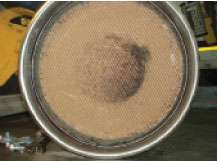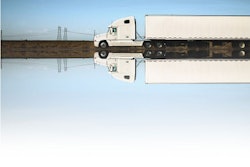How to clean particulate filters
Developing a maintenance routine requires strategy
Diesel particulate filters allow truck diesels to meet ever-tightening emissions standards and help engine makers tune to minimize diesel exhaust fluid consumption. The DPF’s job is similar to that of a canary in a mine. “This form of aftertreatment can be a very good early warning device that can tell you that you have an operating issue with an engine,” says Myron Birschbach, vice president of aftermarket sales for Inland Power Group, a member of the WheelTime service network.
Regardless of its advantages, a device that passes exhaust through the finest filter imaginable is a potential source of trouble – including increased fuel consumption because of backpressure – and expensive repairs. Periodic cleaning removes not only noncombustible ash from oil additives but also small amounts of baked-on carbon that – unlike the bulk of what the unit catches – refuse to burn up and disappear.
A number of competing processes are available to clean the unit, and various programs are available to exchange filters, reducing downtime. A properly managed DPF cleaning program should lead to fuel and maintenance savings.
When to clean?
The first challenge is determining when to clean the unit, as it normally does not make sense to wait for a warning light. “The first step is to determine your duty cycle,” says Bob Giguere, product support manager for Inland Power Group. Is the truck used for long haul, regional or local pickup and delivery? Does it idle eight hours a day? “Each situation needs to be treated differently,” Giguere says. “Under ideal conditions, in over-the-road service, you can go 300,000 miles, but with a lot of idling or local service, you’ll see shorter intervals.”
Fleets normally can follow OEM intervals for original equipment DPFs, but aftermarket unit cleaning should be scheduled by considering the truck’s operating environment. The amount of oil consumed and engine hours are both primary factors; clogging is caused mostly by ash from engine oil, and idling engines use more oil because the piston rings depend in part on the higher cylinder pressures created under load to work at their best.
Today’s fleets must know how, when to clean DPFs.
Gary Parsons, emissions business unit manager for Pacific Power Products of the WheelTime network, recommends following the aftermarket manufacturers’ guidelines. “All the aftermarket units have warning lights,” Parsons says. Drivers should learn to read the indications, which often follow a pattern such as changing colors from yellow to red as the unit clogs. Each operator also should consider all factors when establishing a maintenance routine.
Fleets using OEM equipment should check routinely for updates in maintenance manuals, with the dealer or on the engine maker’s Website. “When we shorten an interval, we send a letter to the customer to inform him, but sometimes intervals are extended,” says Mark Ehlers of the Navistar Customer Service Organization. “In that case, you need to take the initiative to find out about it.”
Volvo recommends cleaning its DPF at 250,000 miles or 4,500 hours, whichever comes first. The DPF is large enough that, with proper maintenance, there is not a significant performance difference between a new filter and a dirty filter. “You will start to notice a difference if the filter becomes full of ash,” says Ed Saxman, manager of Volvo powertrain marketing.
Detroit Diesel’s recommended cleaning interval for most applications is between 300,000 and 400,000 miles. Another way to check is to remove the filter and use a Detroit Diesel service tool to determine capacity, but for most operations, using the standard mileage interval works best, says Brad Williamson, Daimler Trucks North America’s manager of engine and component marketing. Dashboard warning lights take into account several factors and are another reliable indicator, Williamson says.
A driver also needs to pay attention to an increase in the frequency of active regeneration cycles, power loss and declining fuel economy. “Dashboard warning lights simply indicate when regeneration is required or occurring, but they are not an indicator of a required DPF cleaning,” says Larry White of Paccar Parts.
Cleaning options
Opinions on the best ways to clean DPFs differ, and competing methods are available. Williamson says Detroit Diesel’s cleaning process combines liquid and air and is completed at its remanufacturing centers, which have the appropriate tools to facilitate the liquid-air cleaning process, as well as the remanufacturing exchange program.
Baumot North America’s BA 5000 uses air nozzle technology, automatically working through one channel after another and catching dislodged ash via a suction device. The air nozzle directs air through one channel at a time while the DPF substrate rotates 360 degrees during the cleaning process. The air nozzle goes over every channel six times. The BA 5000 allows the DPF to be cleaned as per manufacturer recommendations and is compliant with California Air Resources Board requirements, says Garry McKissick, senior operations manager for Baumot North America.
White warns that all DPF cleaning machines don’t clean similarly. Paccar Parts recommends a machine that employs a visual cleaning process over one that uses a pulse-cleaning process. “Pulse cleaning assumes that all cells are plugged equally and results in inconsistent and incomplete cleaning,” White says, adding that a DPF’s outside cells tend to gather more ash buildup than the cells near the center of the filter.
FSX’s visual cleaning machine involves a four-hour bake of the DPF in an oven that loosens carbon deposits. The machine also features the TrapTester7 airflow test that allows a technician to determine if the filter is clean enough to reinstall on the vehicle.
Cleaning also may have warranty implications. “Understand the process that will be used to clean your product,” Parsons says. The provider must be authorized by the manufacturer and use only a device and cleaning techniques approved by the DPF maker.
Fleets that own a DPF cleaner benefit from greater scheduling flexibility. “They wouldn’t be tied to service center hours,” White says. “It would make sense for a fleet with several hundred power units to buy a DPF cleaner.” White says the economics of buying one versus outsourcing the job depend on the number of trucks in the fleet, the number of miles driven and the trucks’ duty cycles.











